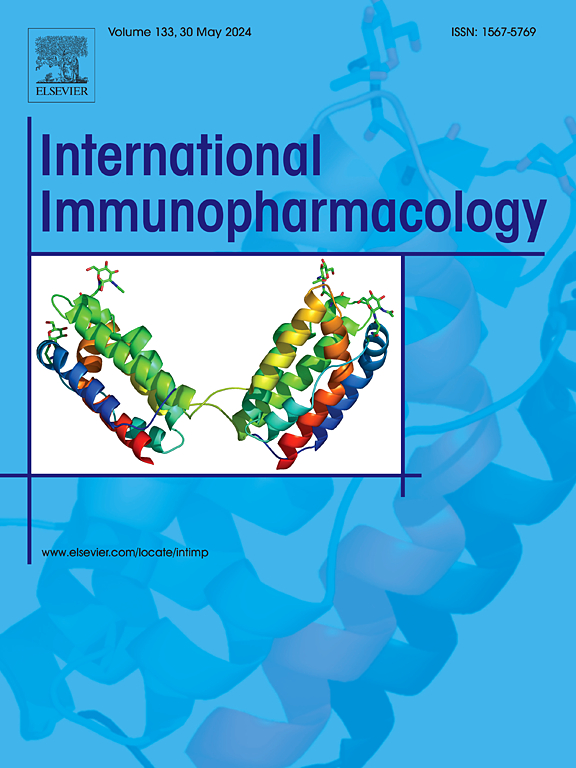细胞治疗在类风湿关节炎中的应用:间充质干细胞的免疫调节策略。
IF 4.8
2区 医学
Q2 IMMUNOLOGY
引用次数: 0
摘要
类风湿性关节炎(RA)是一种常见的慢性自身免疫性疾病,主要影响关节,导致滑膜炎症和增生,随后引起关节疼痛、肿胀和损伤。RA的微环境以缺氧、高活性氧(ROS)、低pH和高炎症因子水平为特征。传统的治疗方法只能部分缓解症状,长期使用往往会引起各种不良反应。因此,迫切需要更安全、更有效的治疗方法。近年来,间充质干细胞(mesenchymal stem cells, MSCs)由于其不同的免疫调节机制,在治疗类风湿性关节炎方面显示出巨大的潜力。MSCs旁分泌多种可溶性因子,通过抑制T细胞增殖或诱导T细胞向调节性T细胞(Tregs)分化、抑制B细胞增殖、分化和免疫球蛋白的产生、促进巨噬细胞向抗炎表型极化、抑制中性粒细胞募集和阻止树突状细胞(DCs)成熟,改善RA患者的炎症微环境。本文综述了间充质干细胞在类风湿关节炎中的免疫调节作用及其在动物模型和临床试验中的应用。虽然间充质干细胞的免疫调节机制尚未完全阐明,但其在类风湿关节炎治疗中的巨大潜力已被广泛认可。未来的研究应进一步探索间充质干细胞的免疫调节机制,优化其在不同病理微环境下的功能,以制定更有效、更安全的治疗策略。本文章由计算机程序翻译,如有差异,请以英文原文为准。

Application of cell therapy in rheumatoid Arthritis: Focusing on the immunomodulatory strategies of Mesenchymal stem cells
Rheumatoid arthritis (RA) is a common chronic autoimmune disease that primarily affects the joints, leading to synovial inflammation and hyperplasia, which subsequently causes joint pain, swelling, and damage. The microenvironment of RA is characterized by hypoxia, high reactive oxygen species (ROS), low pH, and levels of high inflammatory factors. Traditional treatments only partially alleviate symptoms and often cause various adverse reactions with long-term use. Therefore, there is an urgent need for safer and more effective treatments. In recent years, mesenchymal stem cells (MSCs) have shown significant potential in treating RA due to their diverse immunomodulatory mechanisms. MSCs paracrine a variety of soluble factors to improve the inflammatory microenvironment in RA patients by inhibiting T cell proliferation or inducing T cell differentiation to regulatory T cells (Tregs), inhibiting B cell proliferation and differentiation and immunoglobulin production, prompting macrophage polarization toward an anti-inflammatory phenotype, and inhibiting neutrophil recruitment and preventing the maturation of dendritic cells (DCs). This review summarizes the immunomodulatory effects of MSCs in RA and their application in animal models and clinical trials. Although the immunomodulatory mechanisms of MSCs are not yet fully elucidated, their significant potential in RA treatment has been widely recognized. Future research should further explore the immunomodulatory mechanisms of MSCs and optimize their functions in different pathological microenvironments to develop more effective and safer therapeutic strategies.
求助全文
通过发布文献求助,成功后即可免费获取论文全文。
去求助
来源期刊
CiteScore
8.40
自引率
3.60%
发文量
935
审稿时长
53 days
期刊介绍:
International Immunopharmacology is the primary vehicle for the publication of original research papers pertinent to the overlapping areas of immunology, pharmacology, cytokine biology, immunotherapy, immunopathology and immunotoxicology. Review articles that encompass these subjects are also welcome.
The subject material appropriate for submission includes:
• Clinical studies employing immunotherapy of any type including the use of: bacterial and chemical agents; thymic hormones, interferon, lymphokines, etc., in transplantation and diseases such as cancer, immunodeficiency, chronic infection and allergic, inflammatory or autoimmune disorders.
• Studies on the mechanisms of action of these agents for specific parameters of immune competence as well as the overall clinical state.
• Pre-clinical animal studies and in vitro studies on mechanisms of action with immunopotentiators, immunomodulators, immunoadjuvants and other pharmacological agents active on cells participating in immune or allergic responses.
• Pharmacological compounds, microbial products and toxicological agents that affect the lymphoid system, and their mechanisms of action.
• Agents that activate genes or modify transcription and translation within the immune response.
• Substances activated, generated, or released through immunologic or related pathways that are pharmacologically active.
• Production, function and regulation of cytokines and their receptors.
• Classical pharmacological studies on the effects of chemokines and bioactive factors released during immunological reactions.

 求助内容:
求助内容: 应助结果提醒方式:
应助结果提醒方式:


